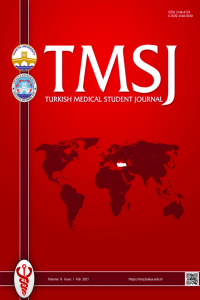Öz
Kaynakça
- 1. Greitz D. Unraveling the riddle of syringomyelia. Neurosurg Rev 2006;29(4):251- 63.
- 2. Vandertop WP. Syringomyelia. Neuropediatrics 2014;45(1):3-9.
- 3. Karam Y, Hitchon PW, Mhanna NE et al. Post-traumatic syringomyelia: Outcome predictors. Clin Neurol Neurosurg 2014;124:44-50.
- 4. Krebs J, Koch HG, Hartmann K et al. The characteristics of posttraumatic syrin- gomyelia. Spinal Cord 2016;54(6):463-6.
- 5. Davidson KA, Rogers JM, Stoodley MA. Syrinx to subarachnoid shunting for sy- ringomyelia. World Neurosurg 2018;110:e53-e59.
- 6. Klekamp J. How should syringomyelia be defined and diagnosed? World neuro- surgery 2018;111:e729-e745.
- 7. Levi AD, Sonntag VK. Management of posttraumatic syringomyelia using an ex pansile duraplasty: A case report. Spine 1998;23(1):128-32.
- 8. Hayashi T, Ueta T, Kubo M et al. Subarachnoid-subarachnoid bypass: A new surgical technique for posttraumatic syringomyelia. J Neurosurg Spine 2013;18(4):382-7.
- 9. Williams B, Page N. Surgical treatment of syringomyelia with syringopleural shunting. Br J Neurosurg 1987;1(1):63-80.
- 10. Barbaro NM, Wilson CB, Gutin PH et al. Surgical treatment of syringomyelia: Favorable results with syringoperitoneal shunting. J Neurosurg 1984;61(3):531-8.
- 11. Aghakhani N, Baussart B, David P et al. Surgical treatment of posttraumatic sy- ringomyelia. Neurosurgery 2010;66(6):1120-7.
Öz
Aims: To present a rare syringomyelia case that necessitated a revision surgery because of a T-tube migration into the syrinx cavity. Case Report: A 53-year-old female patient was presented with progressive pain in the right arm and numbness in the neck. She had undergone decompression and stabilization surgery at the T6-T9 levels four years ago. One year later, she underwent a T-tube placement operation for syringomyelia. She remained relatively stable until the latest admission. A detailed neurological examination revealed no difference compared to her previous neurological condition. Computerized Tomography and Magnetic Resonance Imaging scans demonstrated that the syrinx had expended and the T-tube had migrated into the syrinx cavity. A revision was carried out, the migrated T-tube was removed through fenestration, and a new T-tube was placed. Her condition had significantly improved at follow-up, and the syrinx had markedly regressed. Conclusion: Syringosubarachnoid shunting operations might lead to rare complications such as T-tube migration, which necessitate revision surgery. Nearly complete relief of symptoms can be achieved with successful revision surgery.
Anahtar Kelimeler
Kaynakça
- 1. Greitz D. Unraveling the riddle of syringomyelia. Neurosurg Rev 2006;29(4):251- 63.
- 2. Vandertop WP. Syringomyelia. Neuropediatrics 2014;45(1):3-9.
- 3. Karam Y, Hitchon PW, Mhanna NE et al. Post-traumatic syringomyelia: Outcome predictors. Clin Neurol Neurosurg 2014;124:44-50.
- 4. Krebs J, Koch HG, Hartmann K et al. The characteristics of posttraumatic syrin- gomyelia. Spinal Cord 2016;54(6):463-6.
- 5. Davidson KA, Rogers JM, Stoodley MA. Syrinx to subarachnoid shunting for sy- ringomyelia. World Neurosurg 2018;110:e53-e59.
- 6. Klekamp J. How should syringomyelia be defined and diagnosed? World neuro- surgery 2018;111:e729-e745.
- 7. Levi AD, Sonntag VK. Management of posttraumatic syringomyelia using an ex pansile duraplasty: A case report. Spine 1998;23(1):128-32.
- 8. Hayashi T, Ueta T, Kubo M et al. Subarachnoid-subarachnoid bypass: A new surgical technique for posttraumatic syringomyelia. J Neurosurg Spine 2013;18(4):382-7.
- 9. Williams B, Page N. Surgical treatment of syringomyelia with syringopleural shunting. Br J Neurosurg 1987;1(1):63-80.
- 10. Barbaro NM, Wilson CB, Gutin PH et al. Surgical treatment of syringomyelia: Favorable results with syringoperitoneal shunting. J Neurosurg 1984;61(3):531-8.
- 11. Aghakhani N, Baussart B, David P et al. Surgical treatment of posttraumatic sy- ringomyelia. Neurosurgery 2010;66(6):1120-7.
Ayrıntılar
| Birincil Dil | İngilizce |
|---|---|
| Konular | Klinik Tıp Bilimleri |
| Bölüm | Olgu Sunumu |
| Yazarlar | |
| Yayımlanma Tarihi | 28 Şubat 2021 |
| Gönderilme Tarihi | 18 Ocak 2021 |
| Yayımlandığı Sayı | Yıl 2021 Cilt: 8 Sayı: 1 |


